Da Nang Go Marketing: Comparing Marketing Mix Strategies and Planning
VerifiedAdded on 2021/11/23
|26
|10280
|35
Report
AI Summary
This report, prepared for Da Nang Go, a local nonprofit, analyzes the application of the 7Ps marketing mix (Product, Price, Place, Promotion, People, Process, and Physical Evidence) in different companies to achieve their business objectives. The first part of the report focuses on a comparative analysis of how different organizations utilize the 7Ps. The second part outlines a marketing plan, including tactical action plans and evaluation metrics to monitor the progress and attainment of marketing goals. The report covers key aspects such as consumer and industrial product classifications, the product life cycle, branding, and various pricing strategies, including customer value-based pricing, cost-based pricing, and competitive pricing. The document aims to provide actionable insights for developing and refining marketing strategies for Da Nang Go.
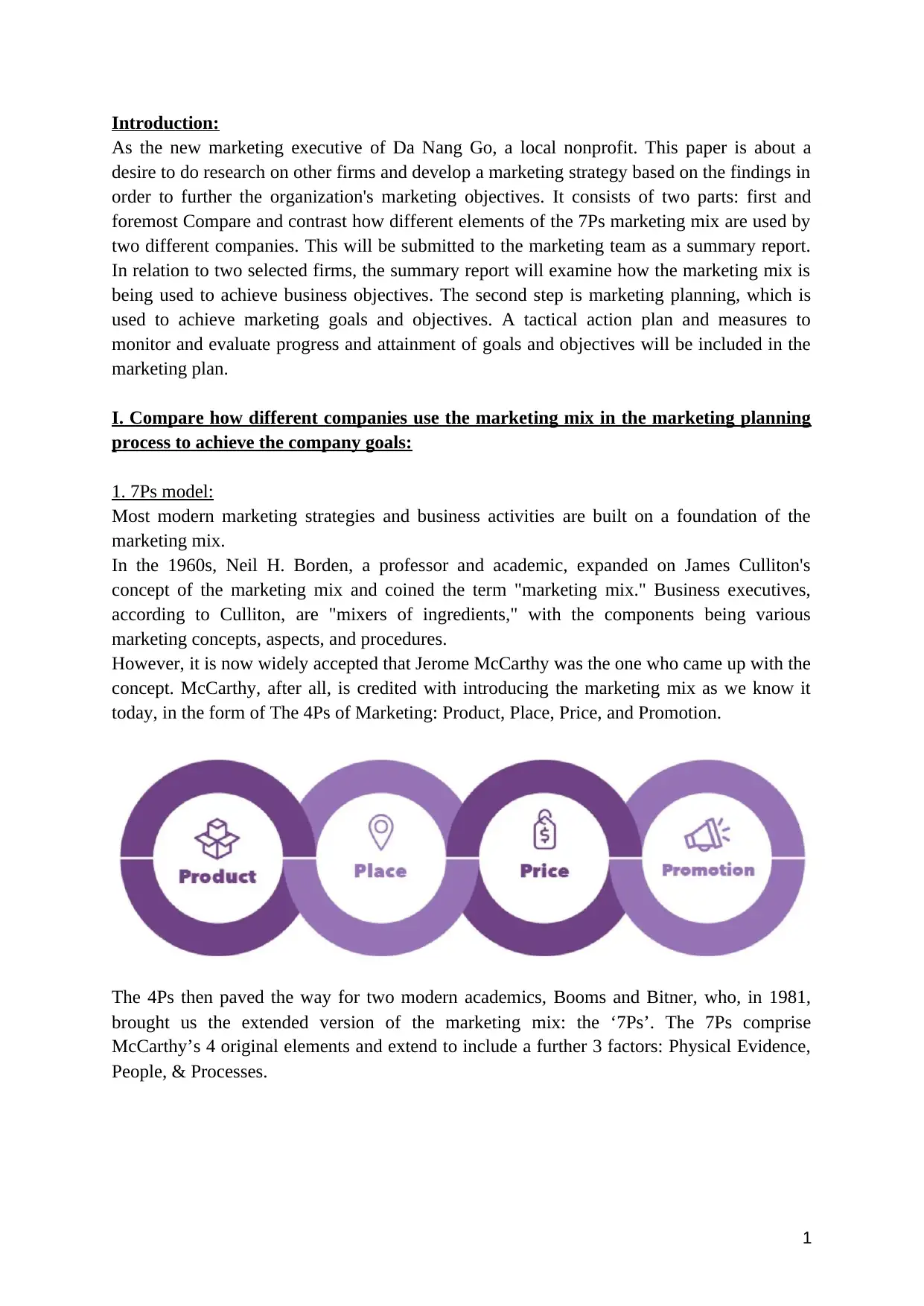
Introduction:
As the new marketing executive of Da Nang Go, a local nonprofit. This paper is about a
desire to do research on other firms and develop a marketing strategy based on the findings in
order to further the organization's marketing objectives. It consists of two parts: first and
foremost Compare and contrast how different elements of the 7Ps marketing mix are used by
two different companies. This will be submitted to the marketing team as a summary report.
In relation to two selected firms, the summary report will examine how the marketing mix is
being used to achieve business objectives. The second step is marketing planning, which is
used to achieve marketing goals and objectives. A tactical action plan and measures to
monitor and evaluate progress and attainment of goals and objectives will be included in the
marketing plan.
I. Compare how different companies use the marketing mix in the marketing planning
process to achieve the company goals:
1. 7Ps model:
Most modern marketing strategies and business activities are built on a foundation of the
marketing mix.
In the 1960s, Neil H. Borden, a professor and academic, expanded on James Culliton's
concept of the marketing mix and coined the term "marketing mix." Business executives,
according to Culliton, are "mixers of ingredients," with the components being various
marketing concepts, aspects, and procedures.
However, it is now widely accepted that Jerome McCarthy was the one who came up with the
concept. McCarthy, after all, is credited with introducing the marketing mix as we know it
today, in the form of The 4Ps of Marketing: Product, Place, Price, and Promotion.
The 4Ps then paved the way for two modern academics, Booms and Bitner, who, in 1981,
brought us the extended version of the marketing mix: the ‘7Ps’. The 7Ps comprise
McCarthy’s 4 original elements and extend to include a further 3 factors: Physical Evidence,
People, & Processes.
1
As the new marketing executive of Da Nang Go, a local nonprofit. This paper is about a
desire to do research on other firms and develop a marketing strategy based on the findings in
order to further the organization's marketing objectives. It consists of two parts: first and
foremost Compare and contrast how different elements of the 7Ps marketing mix are used by
two different companies. This will be submitted to the marketing team as a summary report.
In relation to two selected firms, the summary report will examine how the marketing mix is
being used to achieve business objectives. The second step is marketing planning, which is
used to achieve marketing goals and objectives. A tactical action plan and measures to
monitor and evaluate progress and attainment of goals and objectives will be included in the
marketing plan.
I. Compare how different companies use the marketing mix in the marketing planning
process to achieve the company goals:
1. 7Ps model:
Most modern marketing strategies and business activities are built on a foundation of the
marketing mix.
In the 1960s, Neil H. Borden, a professor and academic, expanded on James Culliton's
concept of the marketing mix and coined the term "marketing mix." Business executives,
according to Culliton, are "mixers of ingredients," with the components being various
marketing concepts, aspects, and procedures.
However, it is now widely accepted that Jerome McCarthy was the one who came up with the
concept. McCarthy, after all, is credited with introducing the marketing mix as we know it
today, in the form of The 4Ps of Marketing: Product, Place, Price, and Promotion.
The 4Ps then paved the way for two modern academics, Booms and Bitner, who, in 1981,
brought us the extended version of the marketing mix: the ‘7Ps’. The 7Ps comprise
McCarthy’s 4 original elements and extend to include a further 3 factors: Physical Evidence,
People, & Processes.
1
Paraphrase This Document
Need a fresh take? Get an instant paraphrase of this document with our AI Paraphraser
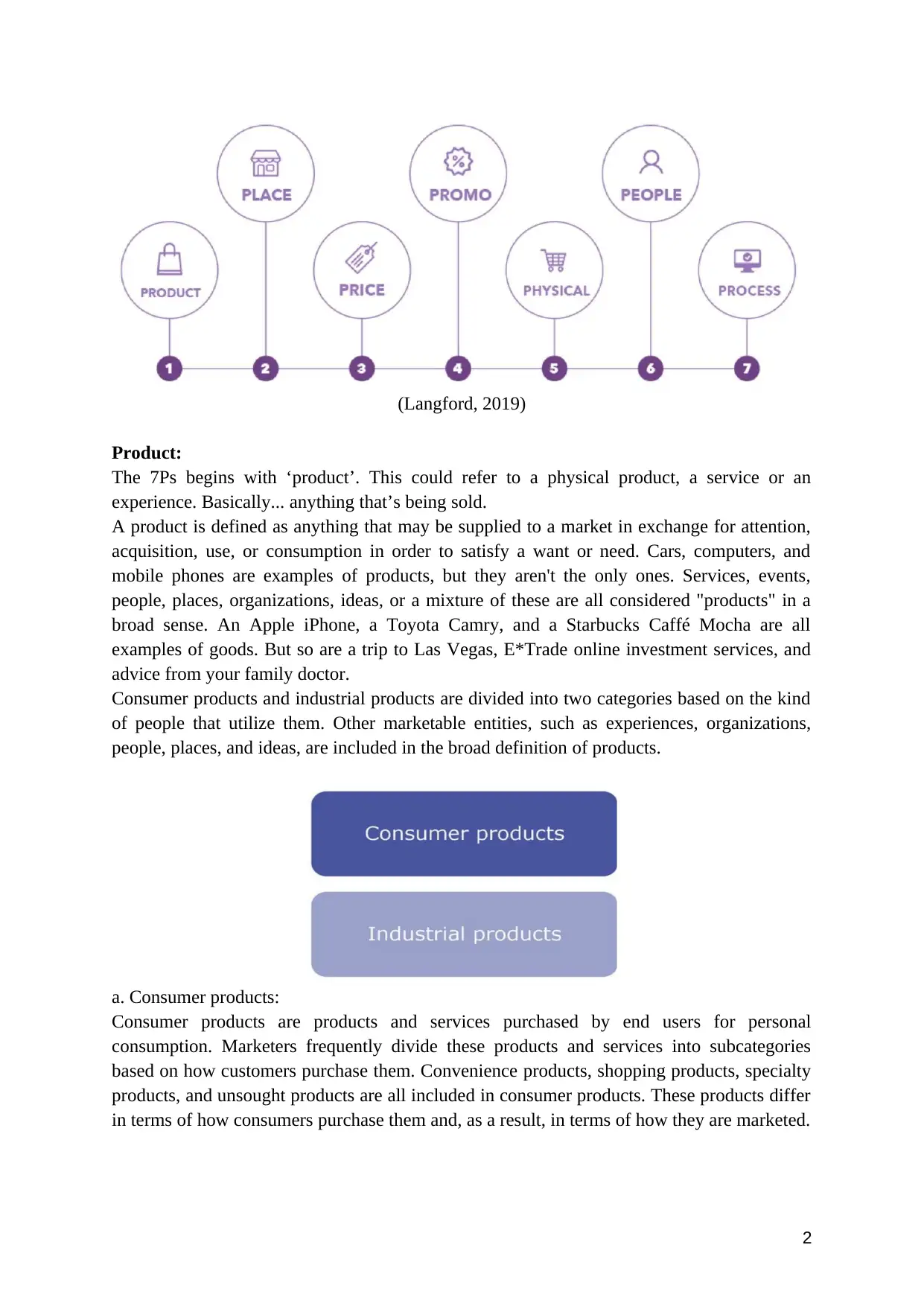
(Langford, 2019)
Product:
The 7Ps begins with ‘product’. This could refer to a physical product, a service or an
experience. Basically... anything that’s being sold.
A product is defined as anything that may be supplied to a market in exchange for attention,
acquisition, use, or consumption in order to satisfy a want or need. Cars, computers, and
mobile phones are examples of products, but they aren't the only ones. Services, events,
people, places, organizations, ideas, or a mixture of these are all considered "products" in a
broad sense. An Apple iPhone, a Toyota Camry, and a Starbucks Caffé Mocha are all
examples of goods. But so are a trip to Las Vegas, E*Trade online investment services, and
advice from your family doctor.
Consumer products and industrial products are divided into two categories based on the kind
of people that utilize them. Other marketable entities, such as experiences, organizations,
people, places, and ideas, are included in the broad definition of products.
a. Consumer products:
Consumer products are products and services purchased by end users for personal
consumption. Marketers frequently divide these products and services into subcategories
based on how customers purchase them. Convenience products, shopping products, specialty
products, and unsought products are all included in consumer products. These products differ
in terms of how consumers purchase them and, as a result, in terms of how they are marketed.
2
Product:
The 7Ps begins with ‘product’. This could refer to a physical product, a service or an
experience. Basically... anything that’s being sold.
A product is defined as anything that may be supplied to a market in exchange for attention,
acquisition, use, or consumption in order to satisfy a want or need. Cars, computers, and
mobile phones are examples of products, but they aren't the only ones. Services, events,
people, places, organizations, ideas, or a mixture of these are all considered "products" in a
broad sense. An Apple iPhone, a Toyota Camry, and a Starbucks Caffé Mocha are all
examples of goods. But so are a trip to Las Vegas, E*Trade online investment services, and
advice from your family doctor.
Consumer products and industrial products are divided into two categories based on the kind
of people that utilize them. Other marketable entities, such as experiences, organizations,
people, places, and ideas, are included in the broad definition of products.
a. Consumer products:
Consumer products are products and services purchased by end users for personal
consumption. Marketers frequently divide these products and services into subcategories
based on how customers purchase them. Convenience products, shopping products, specialty
products, and unsought products are all included in consumer products. These products differ
in terms of how consumers purchase them and, as a result, in terms of how they are marketed.
2
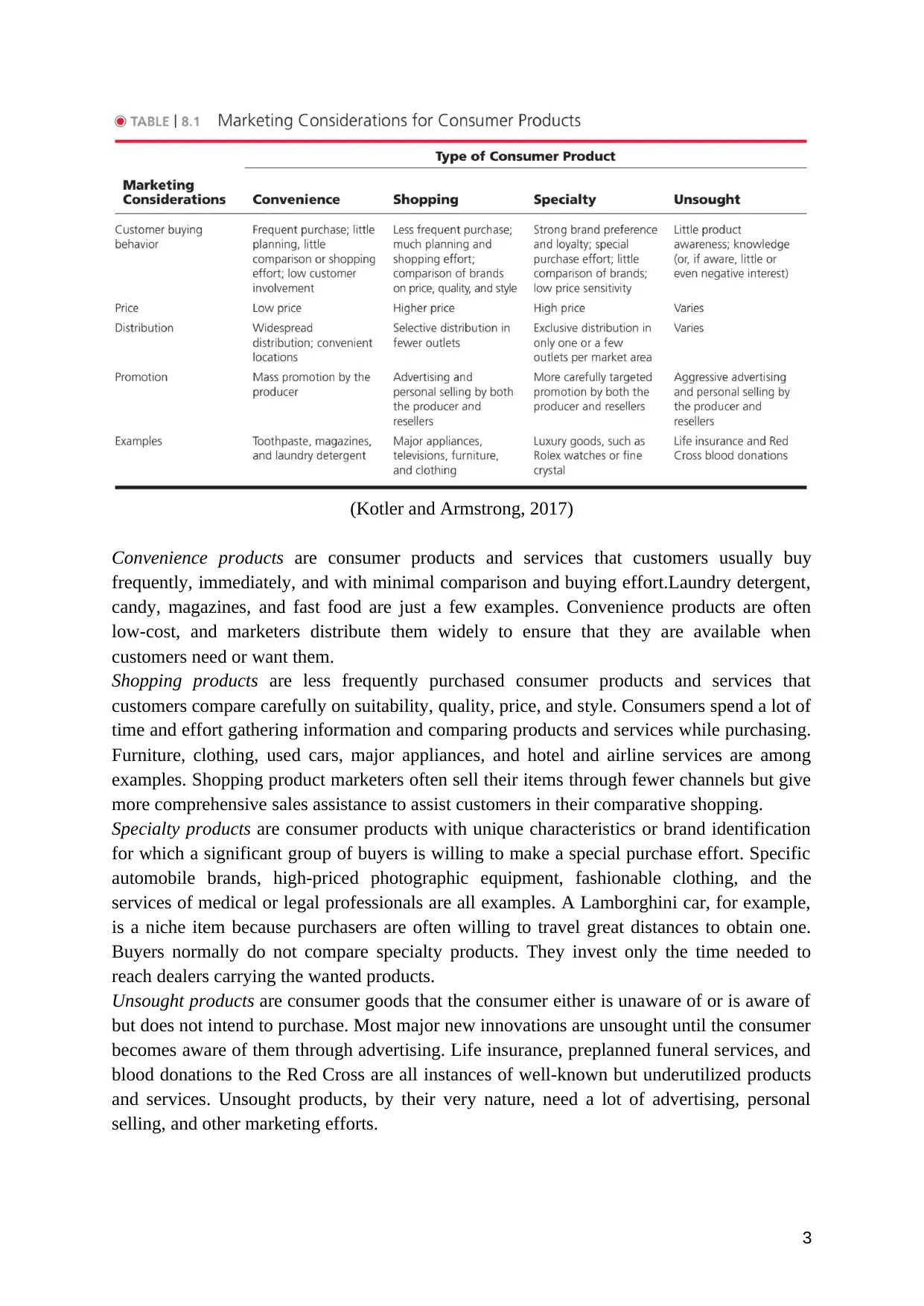
(Kotler and Armstrong, 2017)
Convenience products are consumer products and services that customers usually buy
frequently, immediately, and with minimal comparison and buying effort.Laundry detergent,
candy, magazines, and fast food are just a few examples. Convenience products are often
low-cost, and marketers distribute them widely to ensure that they are available when
customers need or want them.
Shopping products are less frequently purchased consumer products and services that
customers compare carefully on suitability, quality, price, and style. Consumers spend a lot of
time and effort gathering information and comparing products and services while purchasing.
Furniture, clothing, used cars, major appliances, and hotel and airline services are among
examples. Shopping product marketers often sell their items through fewer channels but give
more comprehensive sales assistance to assist customers in their comparative shopping.
Specialty products are consumer products with unique characteristics or brand identification
for which a significant group of buyers is willing to make a special purchase effort. Specific
automobile brands, high-priced photographic equipment, fashionable clothing, and the
services of medical or legal professionals are all examples. A Lamborghini car, for example,
is a niche item because purchasers are often willing to travel great distances to obtain one.
Buyers normally do not compare specialty products. They invest only the time needed to
reach dealers carrying the wanted products.
Unsought products are consumer goods that the consumer either is unaware of or is aware of
but does not intend to purchase. Most major new innovations are unsought until the consumer
becomes aware of them through advertising. Life insurance, preplanned funeral services, and
blood donations to the Red Cross are all instances of well-known but underutilized products
and services. Unsought products, by their very nature, need a lot of advertising, personal
selling, and other marketing efforts.
3
Convenience products are consumer products and services that customers usually buy
frequently, immediately, and with minimal comparison and buying effort.Laundry detergent,
candy, magazines, and fast food are just a few examples. Convenience products are often
low-cost, and marketers distribute them widely to ensure that they are available when
customers need or want them.
Shopping products are less frequently purchased consumer products and services that
customers compare carefully on suitability, quality, price, and style. Consumers spend a lot of
time and effort gathering information and comparing products and services while purchasing.
Furniture, clothing, used cars, major appliances, and hotel and airline services are among
examples. Shopping product marketers often sell their items through fewer channels but give
more comprehensive sales assistance to assist customers in their comparative shopping.
Specialty products are consumer products with unique characteristics or brand identification
for which a significant group of buyers is willing to make a special purchase effort. Specific
automobile brands, high-priced photographic equipment, fashionable clothing, and the
services of medical or legal professionals are all examples. A Lamborghini car, for example,
is a niche item because purchasers are often willing to travel great distances to obtain one.
Buyers normally do not compare specialty products. They invest only the time needed to
reach dealers carrying the wanted products.
Unsought products are consumer goods that the consumer either is unaware of or is aware of
but does not intend to purchase. Most major new innovations are unsought until the consumer
becomes aware of them through advertising. Life insurance, preplanned funeral services, and
blood donations to the Red Cross are all instances of well-known but underutilized products
and services. Unsought products, by their very nature, need a lot of advertising, personal
selling, and other marketing efforts.
3
⊘ This is a preview!⊘
Do you want full access?
Subscribe today to unlock all pages.

Trusted by 1+ million students worldwide
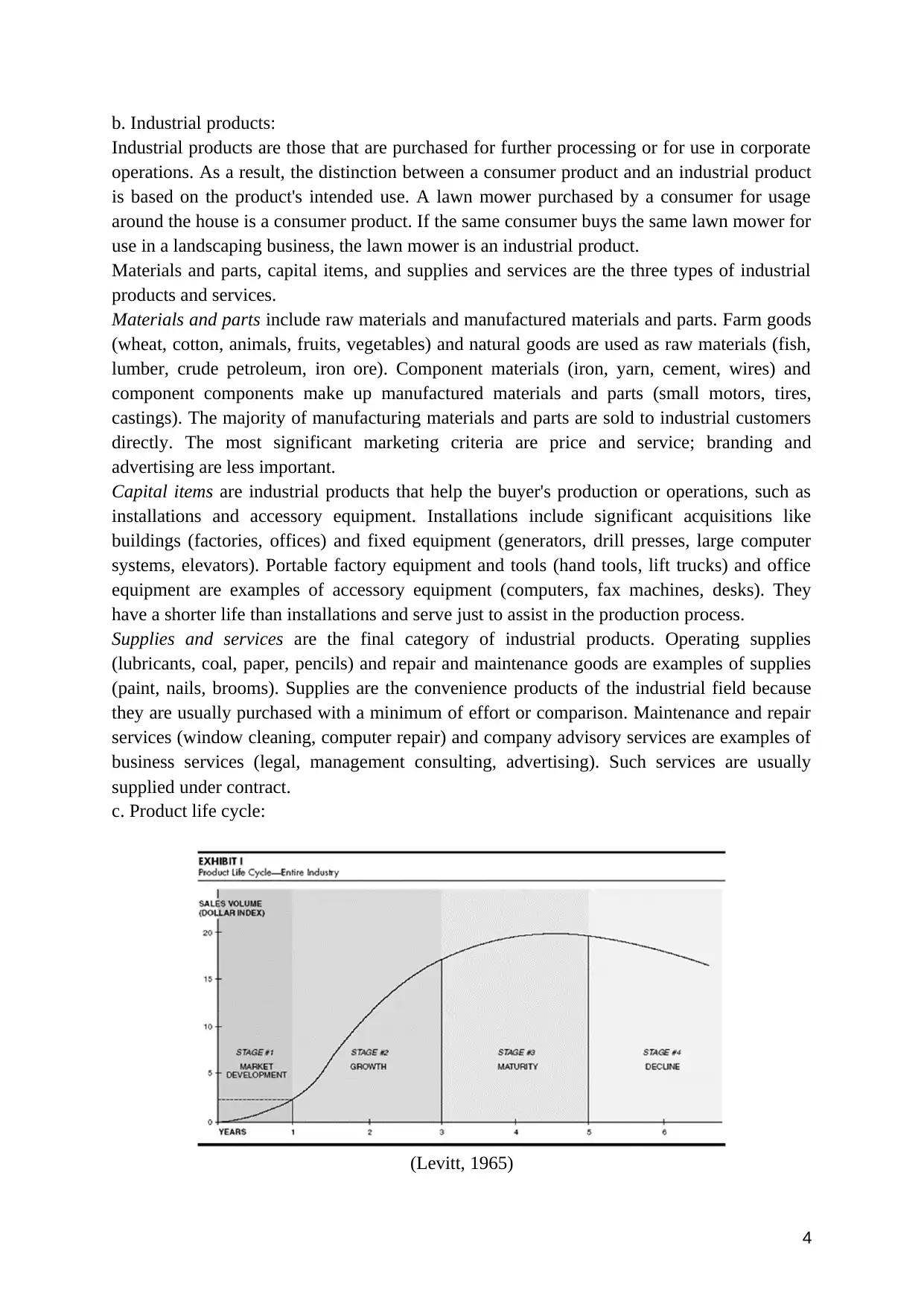
b. Industrial products:
Industrial products are those that are purchased for further processing or for use in corporate
operations. As a result, the distinction between a consumer product and an industrial product
is based on the product's intended use. A lawn mower purchased by a consumer for usage
around the house is a consumer product. If the same consumer buys the same lawn mower for
use in a landscaping business, the lawn mower is an industrial product.
Materials and parts, capital items, and supplies and services are the three types of industrial
products and services.
Materials and parts include raw materials and manufactured materials and parts. Farm goods
(wheat, cotton, animals, fruits, vegetables) and natural goods are used as raw materials (fish,
lumber, crude petroleum, iron ore). Component materials (iron, yarn, cement, wires) and
component components make up manufactured materials and parts (small motors, tires,
castings). The majority of manufacturing materials and parts are sold to industrial customers
directly. The most significant marketing criteria are price and service; branding and
advertising are less important.
Capital items are industrial products that help the buyer's production or operations, such as
installations and accessory equipment. Installations include significant acquisitions like
buildings (factories, offices) and fixed equipment (generators, drill presses, large computer
systems, elevators). Portable factory equipment and tools (hand tools, lift trucks) and office
equipment are examples of accessory equipment (computers, fax machines, desks). They
have a shorter life than installations and serve just to assist in the production process.
Supplies and services are the final category of industrial products. Operating supplies
(lubricants, coal, paper, pencils) and repair and maintenance goods are examples of supplies
(paint, nails, brooms). Supplies are the convenience products of the industrial field because
they are usually purchased with a minimum of effort or comparison. Maintenance and repair
services (window cleaning, computer repair) and company advisory services are examples of
business services (legal, management consulting, advertising). Such services are usually
supplied under contract.
c. Product life cycle:
(Levitt, 1965)
4
Industrial products are those that are purchased for further processing or for use in corporate
operations. As a result, the distinction between a consumer product and an industrial product
is based on the product's intended use. A lawn mower purchased by a consumer for usage
around the house is a consumer product. If the same consumer buys the same lawn mower for
use in a landscaping business, the lawn mower is an industrial product.
Materials and parts, capital items, and supplies and services are the three types of industrial
products and services.
Materials and parts include raw materials and manufactured materials and parts. Farm goods
(wheat, cotton, animals, fruits, vegetables) and natural goods are used as raw materials (fish,
lumber, crude petroleum, iron ore). Component materials (iron, yarn, cement, wires) and
component components make up manufactured materials and parts (small motors, tires,
castings). The majority of manufacturing materials and parts are sold to industrial customers
directly. The most significant marketing criteria are price and service; branding and
advertising are less important.
Capital items are industrial products that help the buyer's production or operations, such as
installations and accessory equipment. Installations include significant acquisitions like
buildings (factories, offices) and fixed equipment (generators, drill presses, large computer
systems, elevators). Portable factory equipment and tools (hand tools, lift trucks) and office
equipment are examples of accessory equipment (computers, fax machines, desks). They
have a shorter life than installations and serve just to assist in the production process.
Supplies and services are the final category of industrial products. Operating supplies
(lubricants, coal, paper, pencils) and repair and maintenance goods are examples of supplies
(paint, nails, brooms). Supplies are the convenience products of the industrial field because
they are usually purchased with a minimum of effort or comparison. Maintenance and repair
services (window cleaning, computer repair) and company advisory services are examples of
business services (legal, management consulting, advertising). Such services are usually
supplied under contract.
c. Product life cycle:
(Levitt, 1965)
4
Paraphrase This Document
Need a fresh take? Get an instant paraphrase of this document with our AI Paraphraser
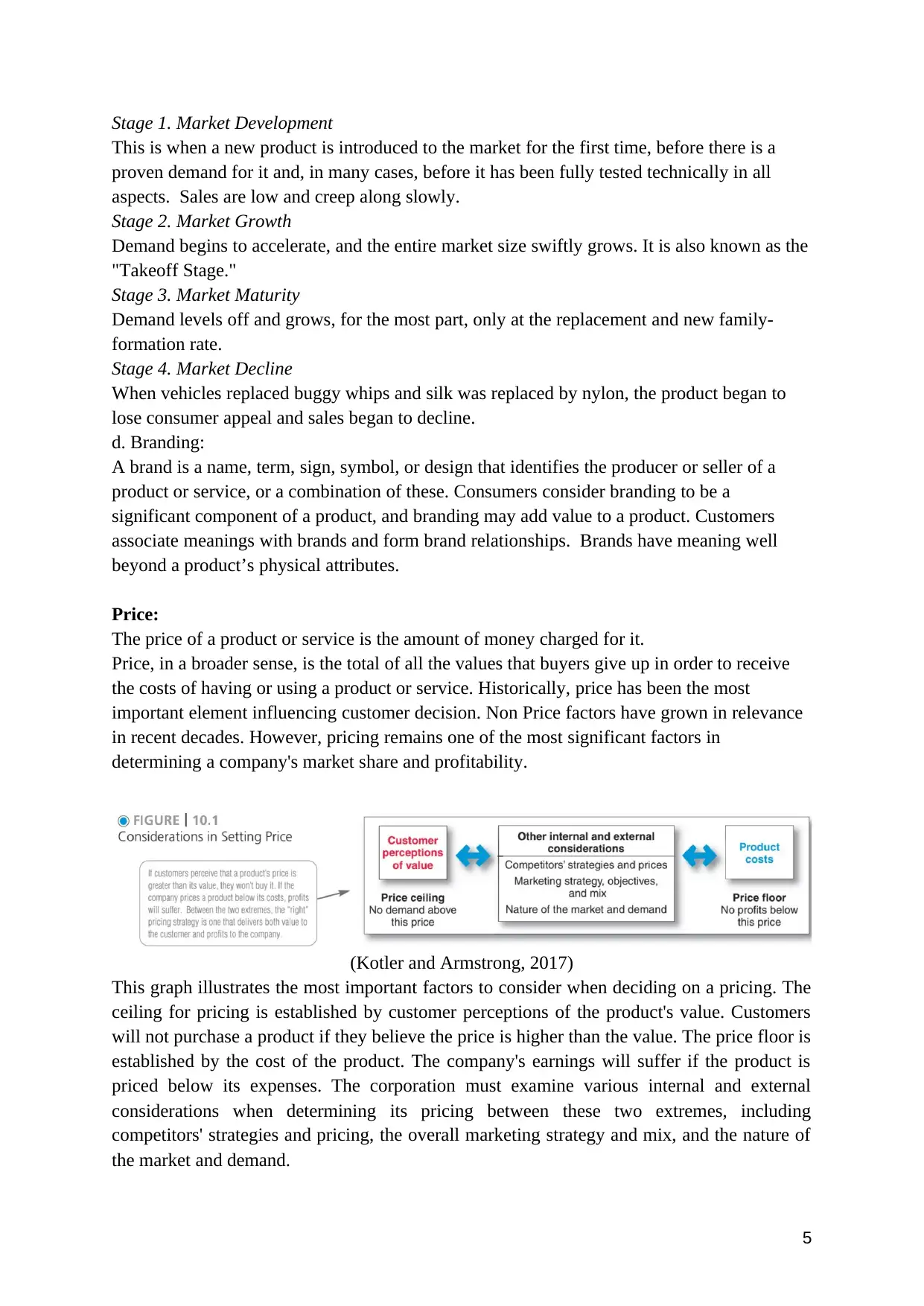
Stage 1. Market Development
This is when a new product is introduced to the market for the first time, before there is a
proven demand for it and, in many cases, before it has been fully tested technically in all
aspects. Sales are low and creep along slowly.
Stage 2. Market Growth
Demand begins to accelerate, and the entire market size swiftly grows. It is also known as the
"Takeoff Stage."
Stage 3. Market Maturity
Demand levels off and grows, for the most part, only at the replacement and new family-
formation rate.
Stage 4. Market Decline
When vehicles replaced buggy whips and silk was replaced by nylon, the product began to
lose consumer appeal and sales began to decline.
d. Branding:
A brand is a name, term, sign, symbol, or design that identifies the producer or seller of a
product or service, or a combination of these. Consumers consider branding to be a
significant component of a product, and branding may add value to a product. Customers
associate meanings with brands and form brand relationships. Brands have meaning well
beyond a product’s physical attributes.
Price:
The price of a product or service is the amount of money charged for it.
Price, in a broader sense, is the total of all the values that buyers give up in order to receive
the costs of having or using a product or service. Historically, price has been the most
important element influencing customer decision. Non Price factors have grown in relevance
in recent decades. However, pricing remains one of the most significant factors in
determining a company's market share and profitability.
(Kotler and Armstrong, 2017)
This graph illustrates the most important factors to consider when deciding on a pricing. The
ceiling for pricing is established by customer perceptions of the product's value. Customers
will not purchase a product if they believe the price is higher than the value. The price floor is
established by the cost of the product. The company's earnings will suffer if the product is
priced below its expenses. The corporation must examine various internal and external
considerations when determining its pricing between these two extremes, including
competitors' strategies and pricing, the overall marketing strategy and mix, and the nature of
the market and demand.
5
This is when a new product is introduced to the market for the first time, before there is a
proven demand for it and, in many cases, before it has been fully tested technically in all
aspects. Sales are low and creep along slowly.
Stage 2. Market Growth
Demand begins to accelerate, and the entire market size swiftly grows. It is also known as the
"Takeoff Stage."
Stage 3. Market Maturity
Demand levels off and grows, for the most part, only at the replacement and new family-
formation rate.
Stage 4. Market Decline
When vehicles replaced buggy whips and silk was replaced by nylon, the product began to
lose consumer appeal and sales began to decline.
d. Branding:
A brand is a name, term, sign, symbol, or design that identifies the producer or seller of a
product or service, or a combination of these. Consumers consider branding to be a
significant component of a product, and branding may add value to a product. Customers
associate meanings with brands and form brand relationships. Brands have meaning well
beyond a product’s physical attributes.
Price:
The price of a product or service is the amount of money charged for it.
Price, in a broader sense, is the total of all the values that buyers give up in order to receive
the costs of having or using a product or service. Historically, price has been the most
important element influencing customer decision. Non Price factors have grown in relevance
in recent decades. However, pricing remains one of the most significant factors in
determining a company's market share and profitability.
(Kotler and Armstrong, 2017)
This graph illustrates the most important factors to consider when deciding on a pricing. The
ceiling for pricing is established by customer perceptions of the product's value. Customers
will not purchase a product if they believe the price is higher than the value. The price floor is
established by the cost of the product. The company's earnings will suffer if the product is
priced below its expenses. The corporation must examine various internal and external
considerations when determining its pricing between these two extremes, including
competitors' strategies and pricing, the overall marketing strategy and mix, and the nature of
the market and demand.
5
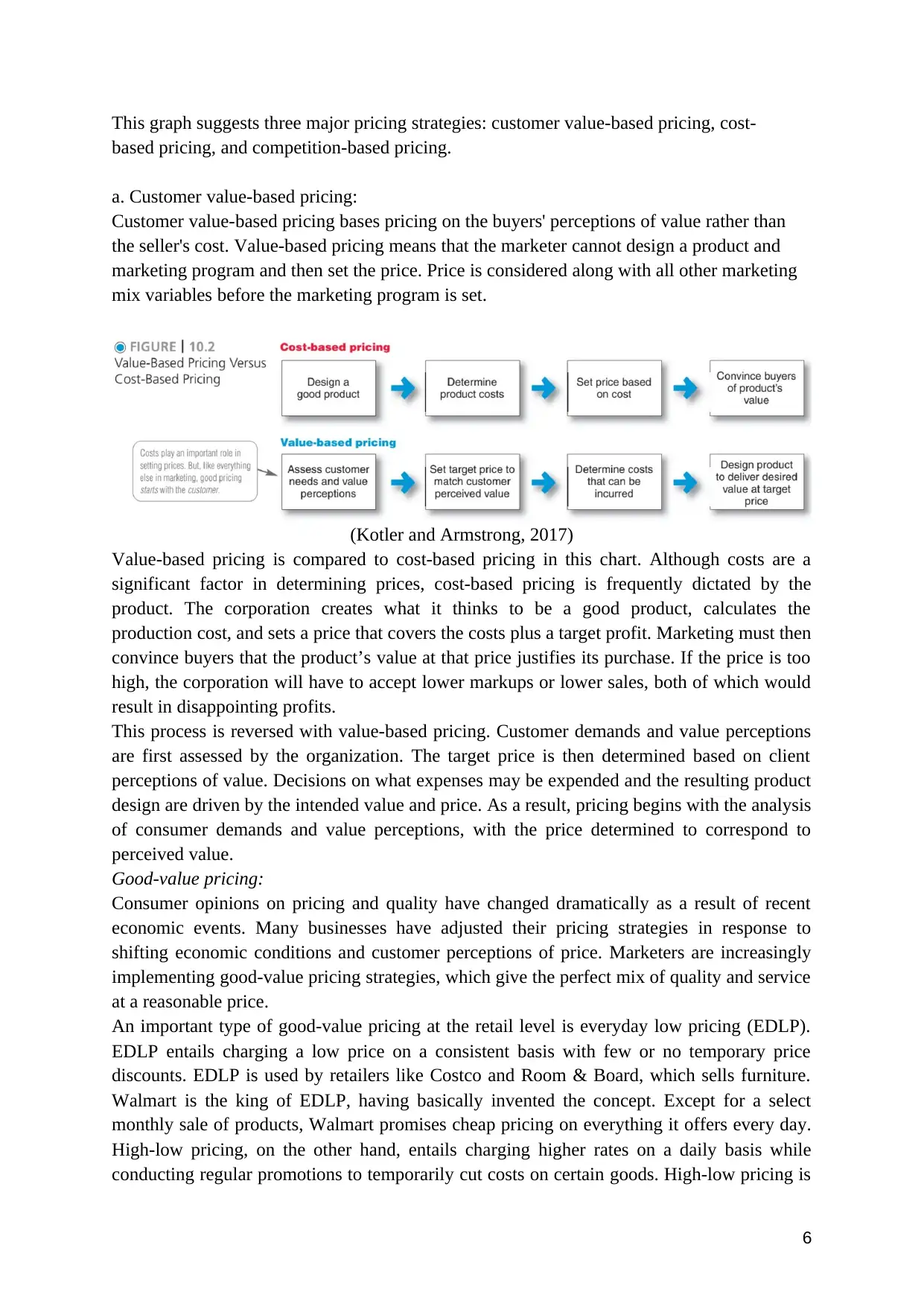
This graph suggests three major pricing strategies: customer value-based pricing, cost-
based pricing, and competition-based pricing.
a. Customer value-based pricing:
Customer value-based pricing bases pricing on the buyers' perceptions of value rather than
the seller's cost. Value-based pricing means that the marketer cannot design a product and
marketing program and then set the price. Price is considered along with all other marketing
mix variables before the marketing program is set.
(Kotler and Armstrong, 2017)
Value-based pricing is compared to cost-based pricing in this chart. Although costs are a
significant factor in determining prices, cost-based pricing is frequently dictated by the
product. The corporation creates what it thinks to be a good product, calculates the
production cost, and sets a price that covers the costs plus a target profit. Marketing must then
convince buyers that the product’s value at that price justifies its purchase. If the price is too
high, the corporation will have to accept lower markups or lower sales, both of which would
result in disappointing profits.
This process is reversed with value-based pricing. Customer demands and value perceptions
are first assessed by the organization. The target price is then determined based on client
perceptions of value. Decisions on what expenses may be expended and the resulting product
design are driven by the intended value and price. As a result, pricing begins with the analysis
of consumer demands and value perceptions, with the price determined to correspond to
perceived value.
Good-value pricing:
Consumer opinions on pricing and quality have changed dramatically as a result of recent
economic events. Many businesses have adjusted their pricing strategies in response to
shifting economic conditions and customer perceptions of price. Marketers are increasingly
implementing good-value pricing strategies, which give the perfect mix of quality and service
at a reasonable price.
An important type of good-value pricing at the retail level is everyday low pricing (EDLP).
EDLP entails charging a low price on a consistent basis with few or no temporary price
discounts. EDLP is used by retailers like Costco and Room & Board, which sells furniture.
Walmart is the king of EDLP, having basically invented the concept. Except for a select
monthly sale of products, Walmart promises cheap pricing on everything it offers every day.
High-low pricing, on the other hand, entails charging higher rates on a daily basis while
conducting regular promotions to temporarily cut costs on certain goods. High-low pricing is
6
based pricing, and competition-based pricing.
a. Customer value-based pricing:
Customer value-based pricing bases pricing on the buyers' perceptions of value rather than
the seller's cost. Value-based pricing means that the marketer cannot design a product and
marketing program and then set the price. Price is considered along with all other marketing
mix variables before the marketing program is set.
(Kotler and Armstrong, 2017)
Value-based pricing is compared to cost-based pricing in this chart. Although costs are a
significant factor in determining prices, cost-based pricing is frequently dictated by the
product. The corporation creates what it thinks to be a good product, calculates the
production cost, and sets a price that covers the costs plus a target profit. Marketing must then
convince buyers that the product’s value at that price justifies its purchase. If the price is too
high, the corporation will have to accept lower markups or lower sales, both of which would
result in disappointing profits.
This process is reversed with value-based pricing. Customer demands and value perceptions
are first assessed by the organization. The target price is then determined based on client
perceptions of value. Decisions on what expenses may be expended and the resulting product
design are driven by the intended value and price. As a result, pricing begins with the analysis
of consumer demands and value perceptions, with the price determined to correspond to
perceived value.
Good-value pricing:
Consumer opinions on pricing and quality have changed dramatically as a result of recent
economic events. Many businesses have adjusted their pricing strategies in response to
shifting economic conditions and customer perceptions of price. Marketers are increasingly
implementing good-value pricing strategies, which give the perfect mix of quality and service
at a reasonable price.
An important type of good-value pricing at the retail level is everyday low pricing (EDLP).
EDLP entails charging a low price on a consistent basis with few or no temporary price
discounts. EDLP is used by retailers like Costco and Room & Board, which sells furniture.
Walmart is the king of EDLP, having basically invented the concept. Except for a select
monthly sale of products, Walmart promises cheap pricing on everything it offers every day.
High-low pricing, on the other hand, entails charging higher rates on a daily basis while
conducting regular promotions to temporarily cut costs on certain goods. High-low pricing is
6
⊘ This is a preview!⊘
Do you want full access?
Subscribe today to unlock all pages.

Trusted by 1+ million students worldwide
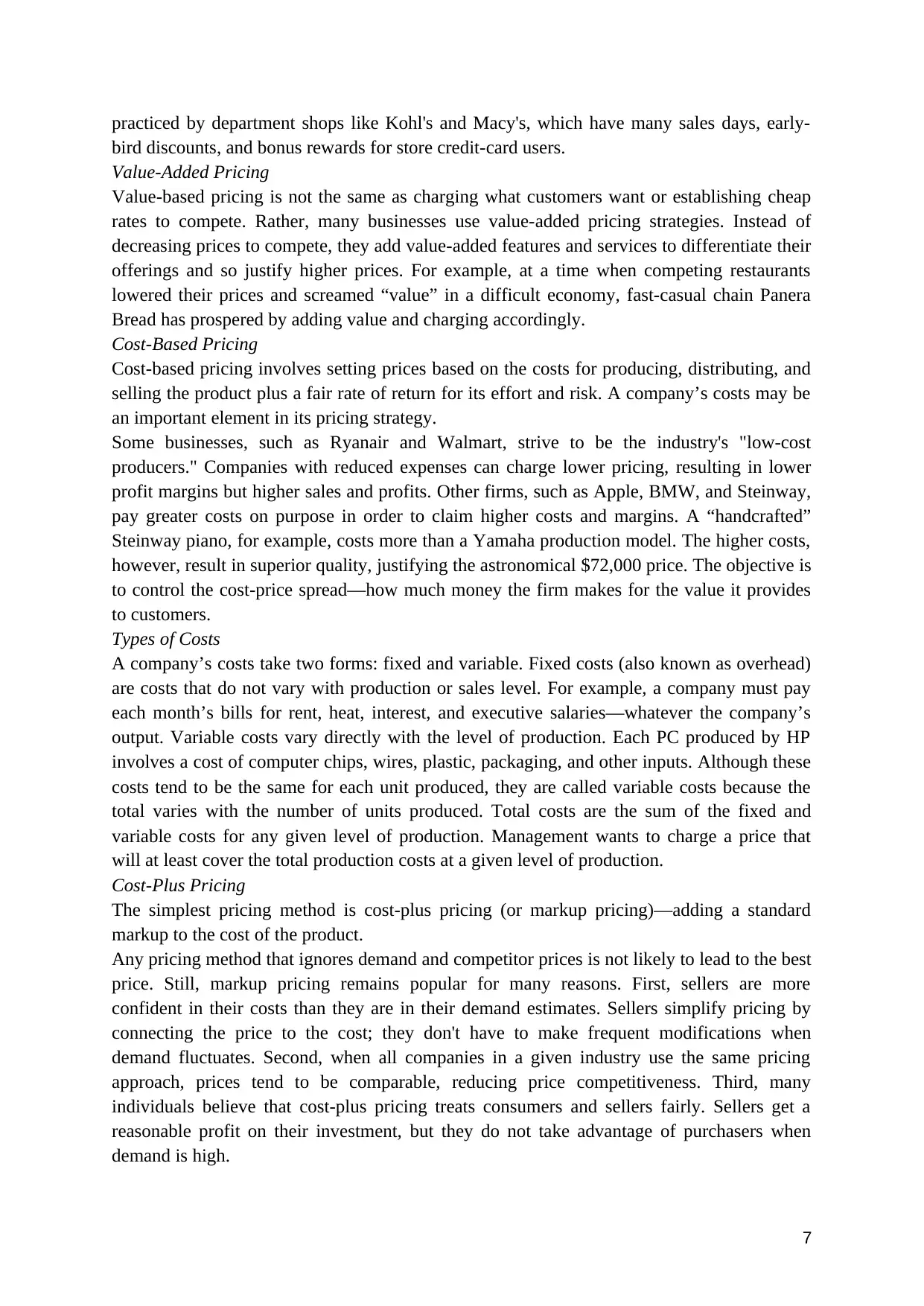
practiced by department shops like Kohl's and Macy's, which have many sales days, early-
bird discounts, and bonus rewards for store credit-card users.
Value-Added Pricing
Value-based pricing is not the same as charging what customers want or establishing cheap
rates to compete. Rather, many businesses use value-added pricing strategies. Instead of
decreasing prices to compete, they add value-added features and services to differentiate their
offerings and so justify higher prices. For example, at a time when competing restaurants
lowered their prices and screamed “value” in a difficult economy, fast-casual chain Panera
Bread has prospered by adding value and charging accordingly.
Cost-Based Pricing
Cost-based pricing involves setting prices based on the costs for producing, distributing, and
selling the product plus a fair rate of return for its effort and risk. A company’s costs may be
an important element in its pricing strategy.
Some businesses, such as Ryanair and Walmart, strive to be the industry's "low-cost
producers." Companies with reduced expenses can charge lower pricing, resulting in lower
profit margins but higher sales and profits. Other firms, such as Apple, BMW, and Steinway,
pay greater costs on purpose in order to claim higher costs and margins. A “handcrafted”
Steinway piano, for example, costs more than a Yamaha production model. The higher costs,
however, result in superior quality, justifying the astronomical $72,000 price. The objective is
to control the cost-price spread—how much money the firm makes for the value it provides
to customers.
Types of Costs
A company’s costs take two forms: fixed and variable. Fixed costs (also known as overhead)
are costs that do not vary with production or sales level. For example, a company must pay
each month’s bills for rent, heat, interest, and executive salaries—whatever the company’s
output. Variable costs vary directly with the level of production. Each PC produced by HP
involves a cost of computer chips, wires, plastic, packaging, and other inputs. Although these
costs tend to be the same for each unit produced, they are called variable costs because the
total varies with the number of units produced. Total costs are the sum of the fixed and
variable costs for any given level of production. Management wants to charge a price that
will at least cover the total production costs at a given level of production.
Cost-Plus Pricing
The simplest pricing method is cost-plus pricing (or markup pricing)—adding a standard
markup to the cost of the product.
Any pricing method that ignores demand and competitor prices is not likely to lead to the best
price. Still, markup pricing remains popular for many reasons. First, sellers are more
confident in their costs than they are in their demand estimates. Sellers simplify pricing by
connecting the price to the cost; they don't have to make frequent modifications when
demand fluctuates. Second, when all companies in a given industry use the same pricing
approach, prices tend to be comparable, reducing price competitiveness. Third, many
individuals believe that cost-plus pricing treats consumers and sellers fairly. Sellers get a
reasonable profit on their investment, but they do not take advantage of purchasers when
demand is high.
7
bird discounts, and bonus rewards for store credit-card users.
Value-Added Pricing
Value-based pricing is not the same as charging what customers want or establishing cheap
rates to compete. Rather, many businesses use value-added pricing strategies. Instead of
decreasing prices to compete, they add value-added features and services to differentiate their
offerings and so justify higher prices. For example, at a time when competing restaurants
lowered their prices and screamed “value” in a difficult economy, fast-casual chain Panera
Bread has prospered by adding value and charging accordingly.
Cost-Based Pricing
Cost-based pricing involves setting prices based on the costs for producing, distributing, and
selling the product plus a fair rate of return for its effort and risk. A company’s costs may be
an important element in its pricing strategy.
Some businesses, such as Ryanair and Walmart, strive to be the industry's "low-cost
producers." Companies with reduced expenses can charge lower pricing, resulting in lower
profit margins but higher sales and profits. Other firms, such as Apple, BMW, and Steinway,
pay greater costs on purpose in order to claim higher costs and margins. A “handcrafted”
Steinway piano, for example, costs more than a Yamaha production model. The higher costs,
however, result in superior quality, justifying the astronomical $72,000 price. The objective is
to control the cost-price spread—how much money the firm makes for the value it provides
to customers.
Types of Costs
A company’s costs take two forms: fixed and variable. Fixed costs (also known as overhead)
are costs that do not vary with production or sales level. For example, a company must pay
each month’s bills for rent, heat, interest, and executive salaries—whatever the company’s
output. Variable costs vary directly with the level of production. Each PC produced by HP
involves a cost of computer chips, wires, plastic, packaging, and other inputs. Although these
costs tend to be the same for each unit produced, they are called variable costs because the
total varies with the number of units produced. Total costs are the sum of the fixed and
variable costs for any given level of production. Management wants to charge a price that
will at least cover the total production costs at a given level of production.
Cost-Plus Pricing
The simplest pricing method is cost-plus pricing (or markup pricing)—adding a standard
markup to the cost of the product.
Any pricing method that ignores demand and competitor prices is not likely to lead to the best
price. Still, markup pricing remains popular for many reasons. First, sellers are more
confident in their costs than they are in their demand estimates. Sellers simplify pricing by
connecting the price to the cost; they don't have to make frequent modifications when
demand fluctuates. Second, when all companies in a given industry use the same pricing
approach, prices tend to be comparable, reducing price competitiveness. Third, many
individuals believe that cost-plus pricing treats consumers and sellers fairly. Sellers get a
reasonable profit on their investment, but they do not take advantage of purchasers when
demand is high.
7
Paraphrase This Document
Need a fresh take? Get an instant paraphrase of this document with our AI Paraphraser
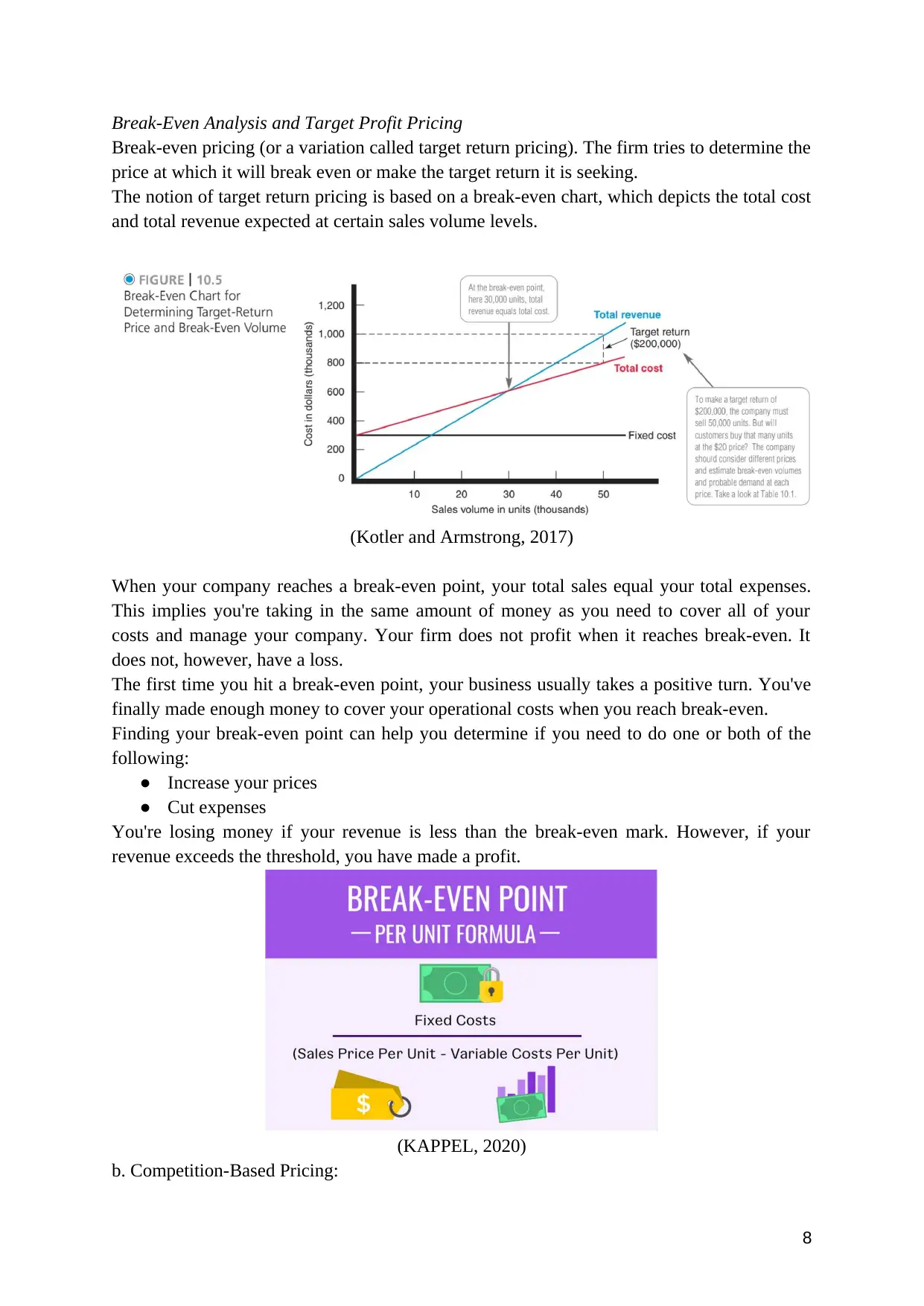
Break-Even Analysis and Target Profit Pricing
Break-even pricing (or a variation called target return pricing). The firm tries to determine the
price at which it will break even or make the target return it is seeking.
The notion of target return pricing is based on a break-even chart, which depicts the total cost
and total revenue expected at certain sales volume levels.
(Kotler and Armstrong, 2017)
When your company reaches a break-even point, your total sales equal your total expenses.
This implies you're taking in the same amount of money as you need to cover all of your
costs and manage your company. Your firm does not profit when it reaches break-even. It
does not, however, have a loss.
The first time you hit a break-even point, your business usually takes a positive turn. You've
finally made enough money to cover your operational costs when you reach break-even.
Finding your break-even point can help you determine if you need to do one or both of the
following:
● Increase your prices
● Cut expenses
You're losing money if your revenue is less than the break-even mark. However, if your
revenue exceeds the threshold, you have made a profit.
(KAPPEL, 2020)
b. Competition-Based Pricing:
8
Break-even pricing (or a variation called target return pricing). The firm tries to determine the
price at which it will break even or make the target return it is seeking.
The notion of target return pricing is based on a break-even chart, which depicts the total cost
and total revenue expected at certain sales volume levels.
(Kotler and Armstrong, 2017)
When your company reaches a break-even point, your total sales equal your total expenses.
This implies you're taking in the same amount of money as you need to cover all of your
costs and manage your company. Your firm does not profit when it reaches break-even. It
does not, however, have a loss.
The first time you hit a break-even point, your business usually takes a positive turn. You've
finally made enough money to cover your operational costs when you reach break-even.
Finding your break-even point can help you determine if you need to do one or both of the
following:
● Increase your prices
● Cut expenses
You're losing money if your revenue is less than the break-even mark. However, if your
revenue exceeds the threshold, you have made a profit.
(KAPPEL, 2020)
b. Competition-Based Pricing:
8
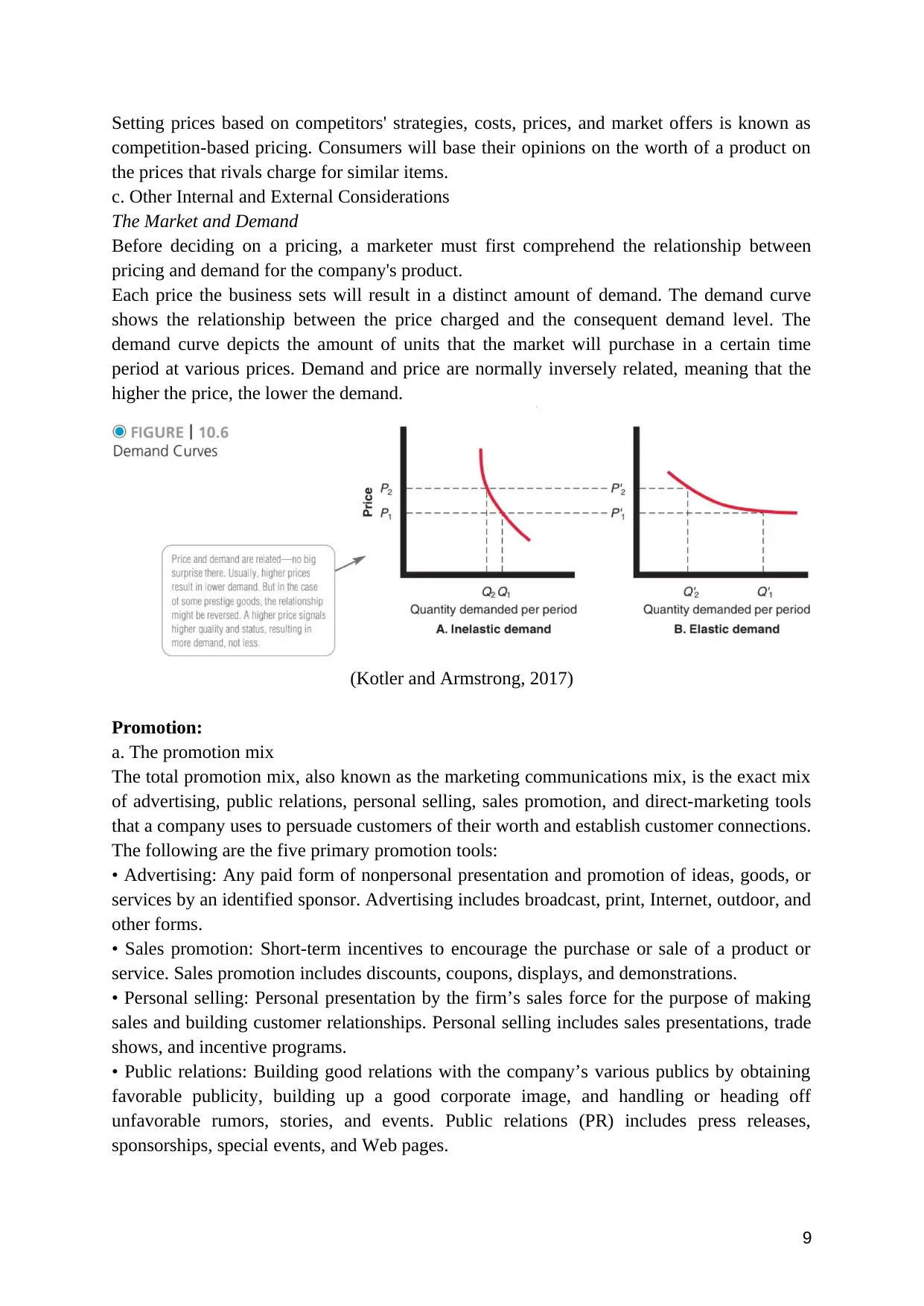
Setting prices based on competitors' strategies, costs, prices, and market offers is known as
competition-based pricing. Consumers will base their opinions on the worth of a product on
the prices that rivals charge for similar items.
c. Other Internal and External Considerations
The Market and Demand
Before deciding on a pricing, a marketer must first comprehend the relationship between
pricing and demand for the company's product.
Each price the business sets will result in a distinct amount of demand. The demand curve
shows the relationship between the price charged and the consequent demand level. The
demand curve depicts the amount of units that the market will purchase in a certain time
period at various prices. Demand and price are normally inversely related, meaning that the
higher the price, the lower the demand.
(Kotler and Armstrong, 2017)
Promotion:
a. The promotion mix
The total promotion mix, also known as the marketing communications mix, is the exact mix
of advertising, public relations, personal selling, sales promotion, and direct-marketing tools
that a company uses to persuade customers of their worth and establish customer connections.
The following are the five primary promotion tools:
• Advertising: Any paid form of nonpersonal presentation and promotion of ideas, goods, or
services by an identified sponsor. Advertising includes broadcast, print, Internet, outdoor, and
other forms.
• Sales promotion: Short-term incentives to encourage the purchase or sale of a product or
service. Sales promotion includes discounts, coupons, displays, and demonstrations.
• Personal selling: Personal presentation by the firm’s sales force for the purpose of making
sales and building customer relationships. Personal selling includes sales presentations, trade
shows, and incentive programs.
• Public relations: Building good relations with the company’s various publics by obtaining
favorable publicity, building up a good corporate image, and handling or heading off
unfavorable rumors, stories, and events. Public relations (PR) includes press releases,
sponsorships, special events, and Web pages.
9
competition-based pricing. Consumers will base their opinions on the worth of a product on
the prices that rivals charge for similar items.
c. Other Internal and External Considerations
The Market and Demand
Before deciding on a pricing, a marketer must first comprehend the relationship between
pricing and demand for the company's product.
Each price the business sets will result in a distinct amount of demand. The demand curve
shows the relationship between the price charged and the consequent demand level. The
demand curve depicts the amount of units that the market will purchase in a certain time
period at various prices. Demand and price are normally inversely related, meaning that the
higher the price, the lower the demand.
(Kotler and Armstrong, 2017)
Promotion:
a. The promotion mix
The total promotion mix, also known as the marketing communications mix, is the exact mix
of advertising, public relations, personal selling, sales promotion, and direct-marketing tools
that a company uses to persuade customers of their worth and establish customer connections.
The following are the five primary promotion tools:
• Advertising: Any paid form of nonpersonal presentation and promotion of ideas, goods, or
services by an identified sponsor. Advertising includes broadcast, print, Internet, outdoor, and
other forms.
• Sales promotion: Short-term incentives to encourage the purchase or sale of a product or
service. Sales promotion includes discounts, coupons, displays, and demonstrations.
• Personal selling: Personal presentation by the firm’s sales force for the purpose of making
sales and building customer relationships. Personal selling includes sales presentations, trade
shows, and incentive programs.
• Public relations: Building good relations with the company’s various publics by obtaining
favorable publicity, building up a good corporate image, and handling or heading off
unfavorable rumors, stories, and events. Public relations (PR) includes press releases,
sponsorships, special events, and Web pages.
9
⊘ This is a preview!⊘
Do you want full access?
Subscribe today to unlock all pages.

Trusted by 1+ million students worldwide
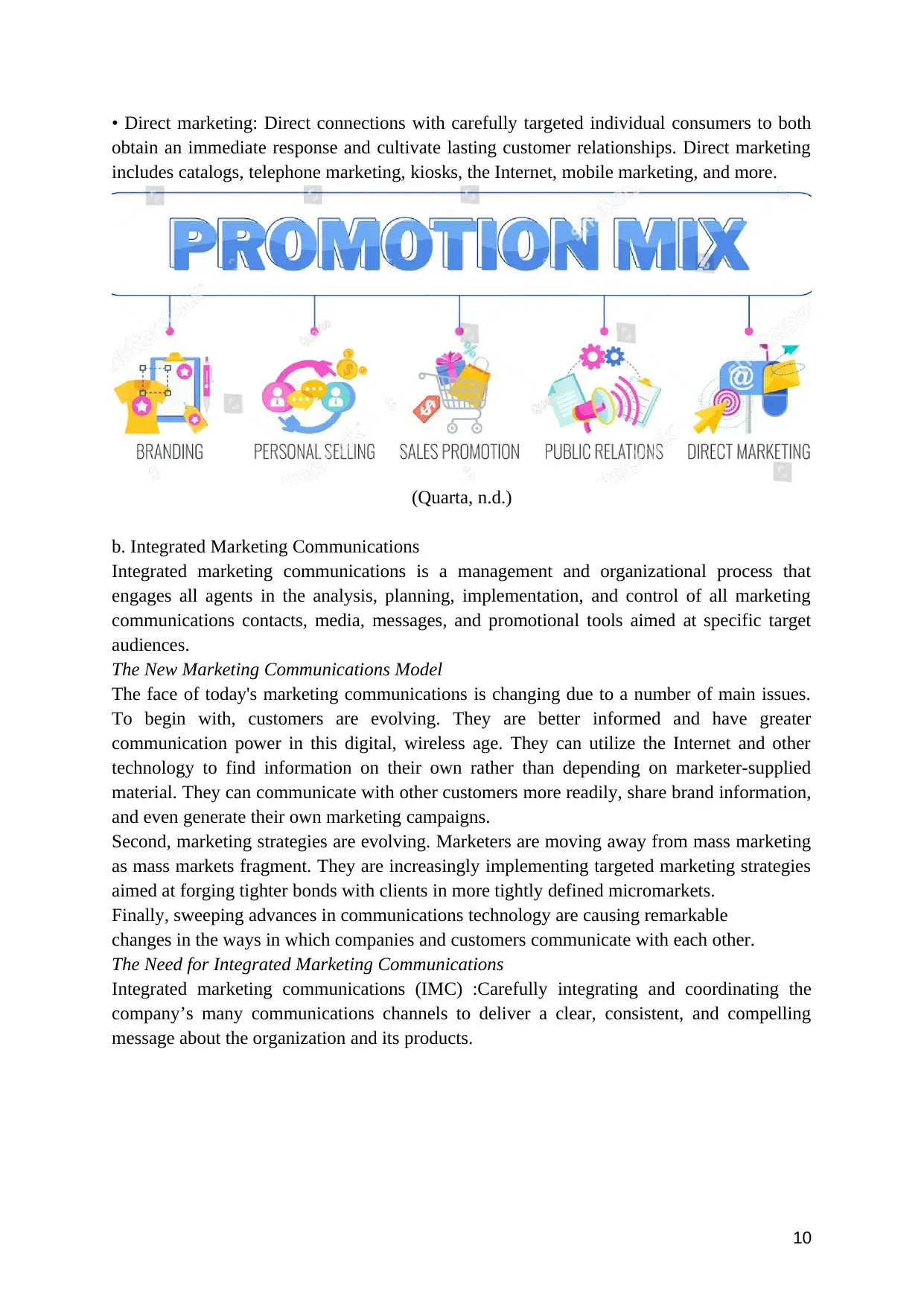
• Direct marketing: Direct connections with carefully targeted individual consumers to both
obtain an immediate response and cultivate lasting customer relationships. Direct marketing
includes catalogs, telephone marketing, kiosks, the Internet, mobile marketing, and more.
(Quarta, n.d.)
b. Integrated Marketing Communications
Integrated marketing communications is a management and organizational process that
engages all agents in the analysis, planning, implementation, and control of all marketing
communications contacts, media, messages, and promotional tools aimed at specific target
audiences.
The New Marketing Communications Model
The face of today's marketing communications is changing due to a number of main issues.
To begin with, customers are evolving. They are better informed and have greater
communication power in this digital, wireless age. They can utilize the Internet and other
technology to find information on their own rather than depending on marketer-supplied
material. They can communicate with other customers more readily, share brand information,
and even generate their own marketing campaigns.
Second, marketing strategies are evolving. Marketers are moving away from mass marketing
as mass markets fragment. They are increasingly implementing targeted marketing strategies
aimed at forging tighter bonds with clients in more tightly defined micromarkets.
Finally, sweeping advances in communications technology are causing remarkable
changes in the ways in which companies and customers communicate with each other.
The Need for Integrated Marketing Communications
Integrated marketing communications (IMC) :Carefully integrating and coordinating the
company’s many communications channels to deliver a clear, consistent, and compelling
message about the organization and its products.
10
obtain an immediate response and cultivate lasting customer relationships. Direct marketing
includes catalogs, telephone marketing, kiosks, the Internet, mobile marketing, and more.
(Quarta, n.d.)
b. Integrated Marketing Communications
Integrated marketing communications is a management and organizational process that
engages all agents in the analysis, planning, implementation, and control of all marketing
communications contacts, media, messages, and promotional tools aimed at specific target
audiences.
The New Marketing Communications Model
The face of today's marketing communications is changing due to a number of main issues.
To begin with, customers are evolving. They are better informed and have greater
communication power in this digital, wireless age. They can utilize the Internet and other
technology to find information on their own rather than depending on marketer-supplied
material. They can communicate with other customers more readily, share brand information,
and even generate their own marketing campaigns.
Second, marketing strategies are evolving. Marketers are moving away from mass marketing
as mass markets fragment. They are increasingly implementing targeted marketing strategies
aimed at forging tighter bonds with clients in more tightly defined micromarkets.
Finally, sweeping advances in communications technology are causing remarkable
changes in the ways in which companies and customers communicate with each other.
The Need for Integrated Marketing Communications
Integrated marketing communications (IMC) :Carefully integrating and coordinating the
company’s many communications channels to deliver a clear, consistent, and compelling
message about the organization and its products.
10
Paraphrase This Document
Need a fresh take? Get an instant paraphrase of this document with our AI Paraphraser
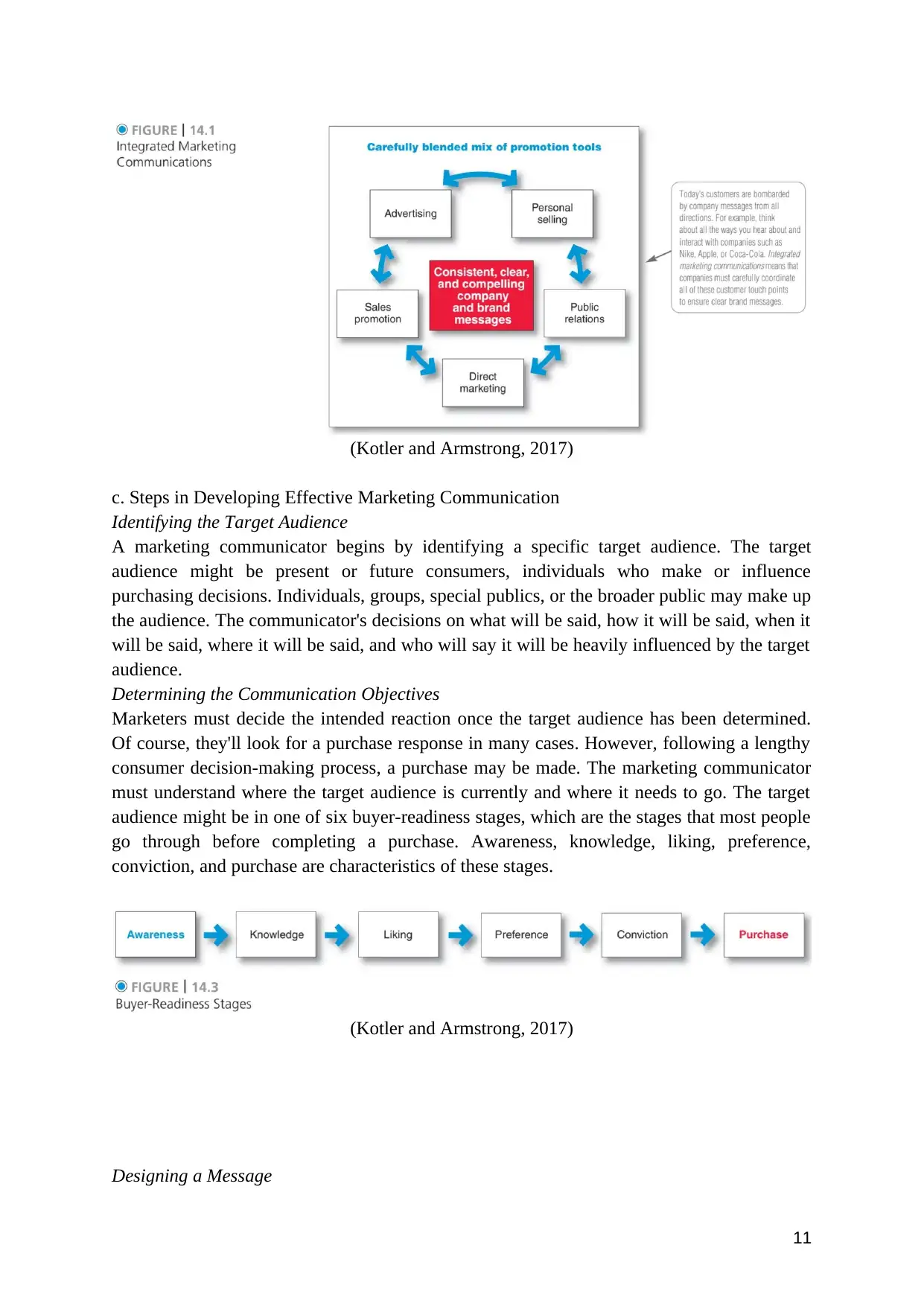
(Kotler and Armstrong, 2017)
c. Steps in Developing Effective Marketing Communication
Identifying the Target Audience
A marketing communicator begins by identifying a specific target audience. The target
audience might be present or future consumers, individuals who make or influence
purchasing decisions. Individuals, groups, special publics, or the broader public may make up
the audience. The communicator's decisions on what will be said, how it will be said, when it
will be said, where it will be said, and who will say it will be heavily influenced by the target
audience.
Determining the Communication Objectives
Marketers must decide the intended reaction once the target audience has been determined.
Of course, they'll look for a purchase response in many cases. However, following a lengthy
consumer decision-making process, a purchase may be made. The marketing communicator
must understand where the target audience is currently and where it needs to go. The target
audience might be in one of six buyer-readiness stages, which are the stages that most people
go through before completing a purchase. Awareness, knowledge, liking, preference,
conviction, and purchase are characteristics of these stages.
(Kotler and Armstrong, 2017)
Designing a Message
11
c. Steps in Developing Effective Marketing Communication
Identifying the Target Audience
A marketing communicator begins by identifying a specific target audience. The target
audience might be present or future consumers, individuals who make or influence
purchasing decisions. Individuals, groups, special publics, or the broader public may make up
the audience. The communicator's decisions on what will be said, how it will be said, when it
will be said, where it will be said, and who will say it will be heavily influenced by the target
audience.
Determining the Communication Objectives
Marketers must decide the intended reaction once the target audience has been determined.
Of course, they'll look for a purchase response in many cases. However, following a lengthy
consumer decision-making process, a purchase may be made. The marketing communicator
must understand where the target audience is currently and where it needs to go. The target
audience might be in one of six buyer-readiness stages, which are the stages that most people
go through before completing a purchase. Awareness, knowledge, liking, preference,
conviction, and purchase are characteristics of these stages.
(Kotler and Armstrong, 2017)
Designing a Message
11
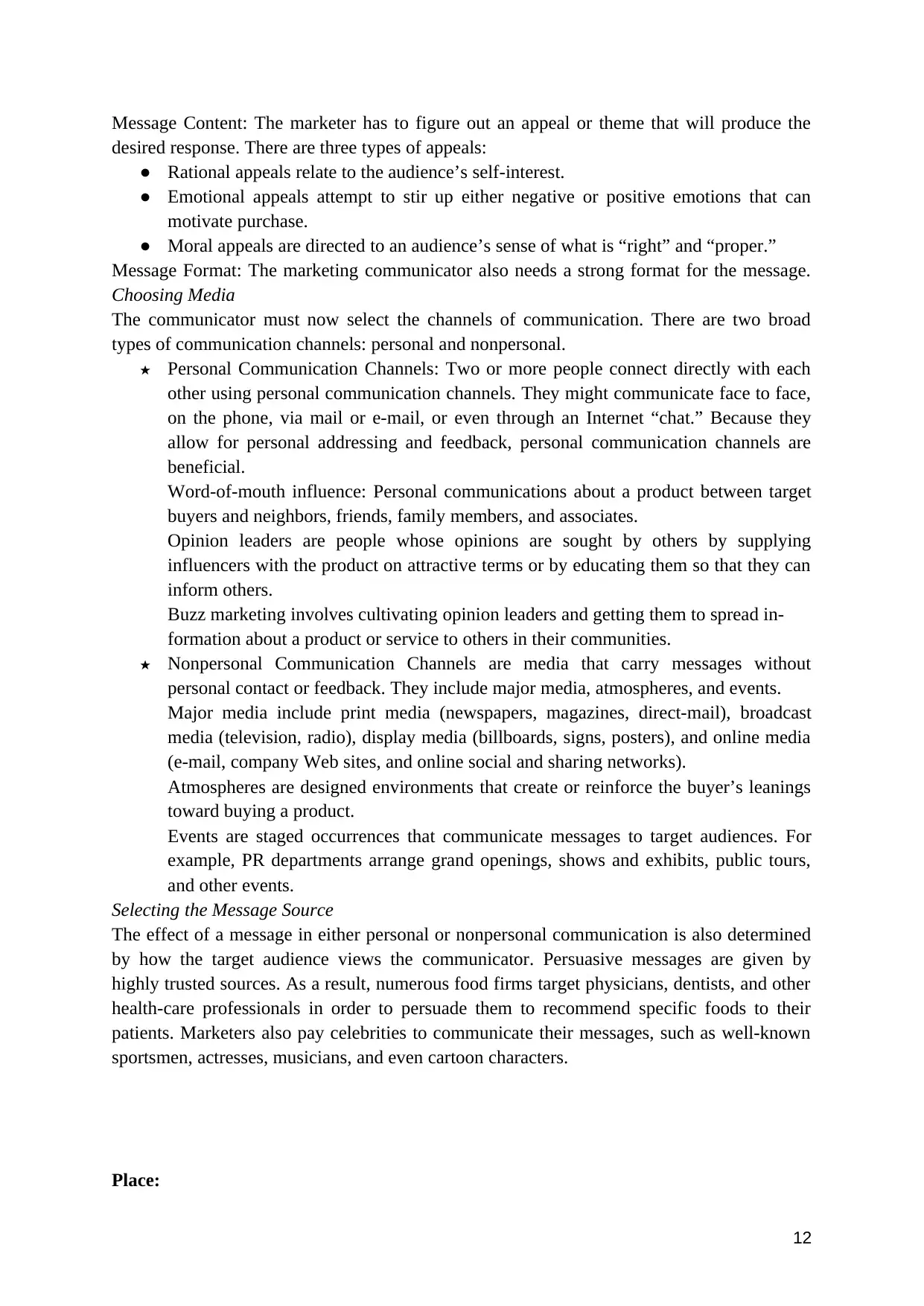
Message Content: The marketer has to figure out an appeal or theme that will produce the
desired response. There are three types of appeals:
● Rational appeals relate to the audience’s self-interest.
● Emotional appeals attempt to stir up either negative or positive emotions that can
motivate purchase.
● Moral appeals are directed to an audience’s sense of what is “right” and “proper.”
Message Format: The marketing communicator also needs a strong format for the message.
Choosing Media
The communicator must now select the channels of communication. There are two broad
types of communication channels: personal and nonpersonal.
★ Personal Communication Channels: Two or more people connect directly with each
other using personal communication channels. They might communicate face to face,
on the phone, via mail or e-mail, or even through an Internet “chat.” Because they
allow for personal addressing and feedback, personal communication channels are
beneficial.
Word-of-mouth influence: Personal communications about a product between target
buyers and neighbors, friends, family members, and associates.
Opinion leaders are people whose opinions are sought by others by supplying
influencers with the product on attractive terms or by educating them so that they can
inform others.
Buzz marketing involves cultivating opinion leaders and getting them to spread in-
formation about a product or service to others in their communities.
★ Nonpersonal Communication Channels are media that carry messages without
personal contact or feedback. They include major media, atmospheres, and events.
Major media include print media (newspapers, magazines, direct-mail), broadcast
media (television, radio), display media (billboards, signs, posters), and online media
(e-mail, company Web sites, and online social and sharing networks).
Atmospheres are designed environments that create or reinforce the buyer’s leanings
toward buying a product.
Events are staged occurrences that communicate messages to target audiences. For
example, PR departments arrange grand openings, shows and exhibits, public tours,
and other events.
Selecting the Message Source
The effect of a message in either personal or nonpersonal communication is also determined
by how the target audience views the communicator. Persuasive messages are given by
highly trusted sources. As a result, numerous food firms target physicians, dentists, and other
health-care professionals in order to persuade them to recommend specific foods to their
patients. Marketers also pay celebrities to communicate their messages, such as well-known
sportsmen, actresses, musicians, and even cartoon characters.
Place:
12
desired response. There are three types of appeals:
● Rational appeals relate to the audience’s self-interest.
● Emotional appeals attempt to stir up either negative or positive emotions that can
motivate purchase.
● Moral appeals are directed to an audience’s sense of what is “right” and “proper.”
Message Format: The marketing communicator also needs a strong format for the message.
Choosing Media
The communicator must now select the channels of communication. There are two broad
types of communication channels: personal and nonpersonal.
★ Personal Communication Channels: Two or more people connect directly with each
other using personal communication channels. They might communicate face to face,
on the phone, via mail or e-mail, or even through an Internet “chat.” Because they
allow for personal addressing and feedback, personal communication channels are
beneficial.
Word-of-mouth influence: Personal communications about a product between target
buyers and neighbors, friends, family members, and associates.
Opinion leaders are people whose opinions are sought by others by supplying
influencers with the product on attractive terms or by educating them so that they can
inform others.
Buzz marketing involves cultivating opinion leaders and getting them to spread in-
formation about a product or service to others in their communities.
★ Nonpersonal Communication Channels are media that carry messages without
personal contact or feedback. They include major media, atmospheres, and events.
Major media include print media (newspapers, magazines, direct-mail), broadcast
media (television, radio), display media (billboards, signs, posters), and online media
(e-mail, company Web sites, and online social and sharing networks).
Atmospheres are designed environments that create or reinforce the buyer’s leanings
toward buying a product.
Events are staged occurrences that communicate messages to target audiences. For
example, PR departments arrange grand openings, shows and exhibits, public tours,
and other events.
Selecting the Message Source
The effect of a message in either personal or nonpersonal communication is also determined
by how the target audience views the communicator. Persuasive messages are given by
highly trusted sources. As a result, numerous food firms target physicians, dentists, and other
health-care professionals in order to persuade them to recommend specific foods to their
patients. Marketers also pay celebrities to communicate their messages, such as well-known
sportsmen, actresses, musicians, and even cartoon characters.
Place:
12
⊘ This is a preview!⊘
Do you want full access?
Subscribe today to unlock all pages.

Trusted by 1+ million students worldwide
1 out of 26
Related Documents
Your All-in-One AI-Powered Toolkit for Academic Success.
+13062052269
info@desklib.com
Available 24*7 on WhatsApp / Email
![[object Object]](/_next/static/media/star-bottom.7253800d.svg)
Unlock your academic potential
Copyright © 2020–2025 A2Z Services. All Rights Reserved. Developed and managed by ZUCOL.




